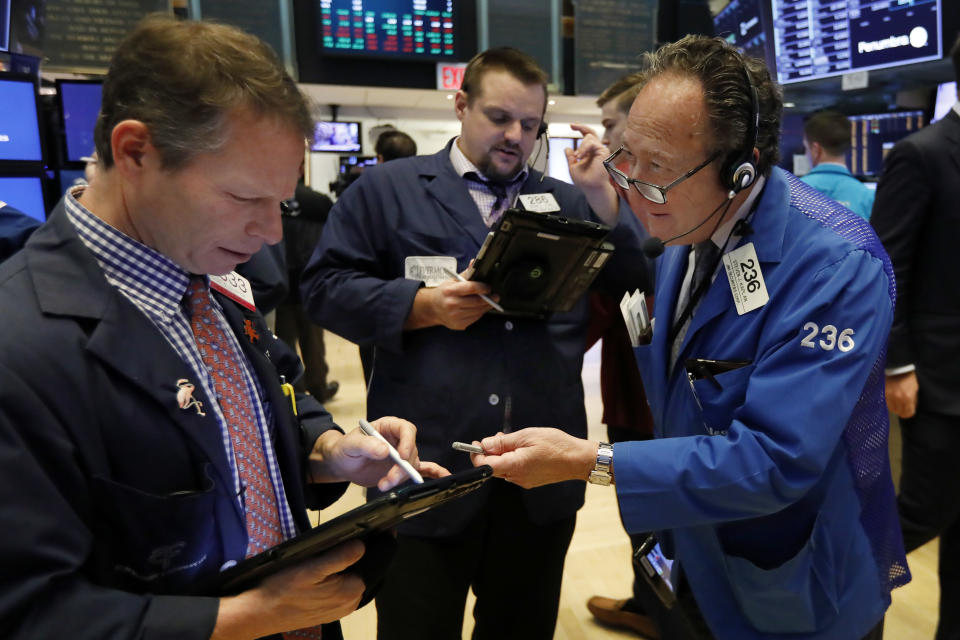The stock market is at a record high and it's unbelievable
And here we are again folks, the stock market is at record highs. It all feels rather bizarro, no?
A year of wild Trump tweets on his trade war with China. Stocks have shrugged them off. It’s been a year of decelerating global economic growth — thanks to that Trump trade war — and gloomy predictions from the likes of the IMF, and stocks could seemingly care less. Earnings growth in Corporate America has slowed noticeably through the first three quarters of the year. Mr. Market says who gives a damn, brighter days lay ahead in 2020.
Recession calls? That was so summer 2019. Sub-$60 a barrel oil prices suggesting global economic doom lurking in the weeds? Nope, hasn’t happened.
Yet, with just over two months left in 2018, the fear of missing out (referred to as “FOMO” on the Street) on more gains in the market is beginning to rain down on Wall Street sentiment. The purest form of that could be found in the major benchmark indices, notably the record-setting S&P 500. Year-to-date, the Nasdaq Composite is up roughly 24%, the S&P 500 has gained 21% and the Dow Jones Industrial Average has tacked on 16%.
This market is on autopilot!
To be sure, the latest push higher in stocks has stumped many seasoned pros on Wall Street. The helping hand of interest rate cuts from the Federal Reserve has driven valuation expansion across many sectors. But by and large the experts are still in awe as to how bad earnings reports from a Caterpillar (CAT) and FedEx (FDX) could be overlooked along with a U.S. manufacturing recession and a sharp slowdown in Chinese economic growth.
Add to that Trump’s “phase one” trade deal arguably doesn’t amount to a hill of beans besides just cooling investor jitters.
“If everything is OK on the economic front, why is the Fed cutting interest rates,” Diamond Hill Capital Management portfolio manager John McClain tells Yahoo Finance’s The First Trade. “Valuations are rich for what we are seeing out of economic data. We continue to see deceleration in global growth across the board. And what really is helping valuations is quantitative easing across the globe and supportive monetary policy.”
So, then why the fresh records?
Why stocks are rallying
The recent surge in stocks could be boiled down to several factors.
First, third quarter earnings season hasn’t completely stunk. For every bad earnings report from a Caterpillar and FedEx, there have been more upbeat reads from a Microsoft (MSFT) and to a lesser extent Amazon (AMZN).
About 50% of the S&P 500 have reported third quarter earnings, with bottom lines coming in 2% above consensus forecasts, according to Bank of American Merrill Lynch. After months of recession calls on Wall Street, by no means was an earnings season of beats priced into equities. Earnings estimates for the S&P 500 are now slightly on the rise, says BofA, supporting healthier valuations for companies. Capital expenditure spending also hasn’t fallen off a cliff even as trade uncertainty persists, per BofA data.

The lack of a capex plunge has unlocked another aspect to the stock market rally: the logic that economic data in the U.S. has bottomed.
“Take a look at Caterpillar, it got nailed [in the quarter] but just the fact they said they are cutting production and the stock bounced back, and it says traders and investors think the economic data is bottoming and at the margin, demand will begin to inch higher,” says Prudential Financial Chief markets strategist Quincy Krosby.
Meanwhile, consumer companies from PepsiCo (PEP) to Coca-Cola (KO) to McDonald’s (MCD) to Restaurant Brands (QRS0 had strong third quarters. That has underpinned the view that despite heightened trade tensions spurring job uncertainty, the economic engine that is the U.S. consumer remains strong with unemployment at 50-year lows.
Target (TGT) CEO Brian Cornell flat out told Yahoo Finance a week ago the U.S. consumer is healthy. The company’s third quarter has continued the momentum it saw in the second quarter, Cornell said.
Factor in at least one more interest rate cut from the Fed before yearend and the “phase one” trade deal almost in the bag, it would make sense the market would be in rally. It’s surprising, but there is logic behind it no doubt.
“It [market records] is pretty amazing. But the market tends to see changes in economic data before the economic data is released,” says Krosby.
Let the rally carry-on
And now the bulls look primed to sit back and watch — and of course partake in — a potential market melt-up into yearend. That would be dramatically different than the fourth quarter of 2018, where a rate hiking Fed tanked the stock market in December.
“If you see better economic data hit the headlines, you will see some of that money on the sidelines coming in. We have more money in money market funds than since the Lehman Brothers crash, and that money will probably come into the markets if people feel more comfortable with the economic underpinning,” Krosby says. “It looks like the market wants to move higher.”
Amazing to see given all that has transpired this year. And very hard to understand, or is it really? Rally on.
Brian Sozzi is an editor-at-large and co-anchor of The First Trade at Yahoo Finance. Follow him on Twitter @BrianSozzi
Read the latest financial and business news from Yahoo Finance
SmileDirect co-founder: here’s what life will look like post IPO
Starbucks CEO on what China has in store for the coffee giant
Follow Yahoo Finance on Twitter, Facebook, Instagram, Flipboard, SmartNews, LinkedIn, YouTube, and reddit.

 Yahoo Finance
Yahoo Finance 